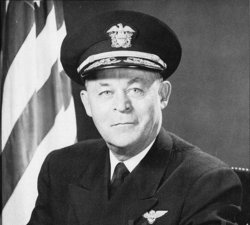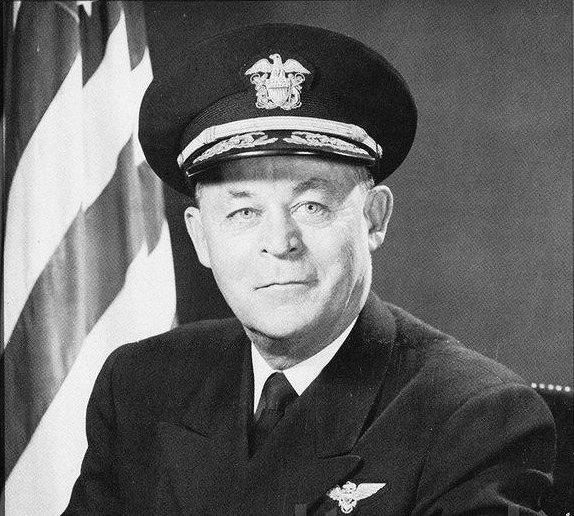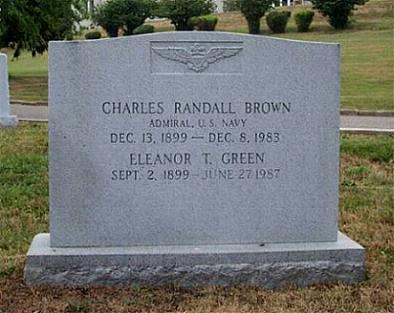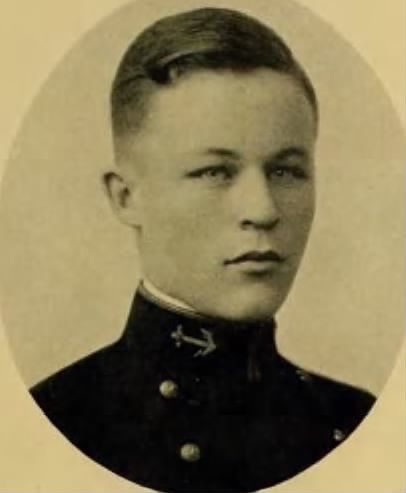He began his naval career in 1917 when he received an appointment to the US Naval Academy at Annapolis, Maryland. Following his graduation in 1921, he attended flight training and earned his pilot's wings in 1924. During World War II, he commanded the escort carrier USS Kalinin Bay (1943 to 1944) and the aircraft carrier USS Hornet (1945 to 1946) in the Pacific Theater of Operations and participated in the Marianas Campaign, the Battle of Leyte Gulf, and the Philippines Campaign. From 1944 until 1945 he served as Commander, Carrier Strike Group I.
In 1956 he was promoted to the rank of vice admiral, with assignments as the Commander of Naval Forces Europe/Commander 6th Fleet (1956 to 1958), US Naval Forces, Central Command (1958), and Supreme Headquarters Allied Powers in Europe/Allied Naval Forces Southern Europe (1959). In 1959 he was promoted to the rank of admiral and became Commander-in-Chief of Allied Forces Southern Europe and retired in this position in 1962 with 41 years of continuous military service.
Among his military and foreign awards and decorations include the Navy Distinguished Service Medal, the Legion of Merit (with combat "V" device), the Bronze Star, the Navy Presidential Unit Citation (with star), the China Service Medal (with star), the American Defense Service Medal (with star), the American Campaign Medal, the Asiatic/Pacific Campaign Medal, the World War II Victory Medal, the Navy Occupation Service Medal, the National Defense Service Medal (with star), the Philippine Presidential Unit Citation, the Philippine Defense Medal, the Philippine Liberation Medal, and the Philippine Independence Medal.
While serving as Commander-in Chief of Allied Forces in Southern Europe, he came up with the idea of the Gray Eagle Award, presented to the Naval Aviator on active duty in the US Navy or Marine Corps who has held that designation for the longest period of time, and he was the first to receive the award while on active duty. He died at the age of 83.
He began his naval career in 1917 when he received an appointment to the US Naval Academy at Annapolis, Maryland. Following his graduation in 1921, he attended flight training and earned his pilot's wings in 1924. During World War II, he commanded the escort carrier USS Kalinin Bay (1943 to 1944) and the aircraft carrier USS Hornet (1945 to 1946) in the Pacific Theater of Operations and participated in the Marianas Campaign, the Battle of Leyte Gulf, and the Philippines Campaign. From 1944 until 1945 he served as Commander, Carrier Strike Group I.
In 1956 he was promoted to the rank of vice admiral, with assignments as the Commander of Naval Forces Europe/Commander 6th Fleet (1956 to 1958), US Naval Forces, Central Command (1958), and Supreme Headquarters Allied Powers in Europe/Allied Naval Forces Southern Europe (1959). In 1959 he was promoted to the rank of admiral and became Commander-in-Chief of Allied Forces Southern Europe and retired in this position in 1962 with 41 years of continuous military service.
Among his military and foreign awards and decorations include the Navy Distinguished Service Medal, the Legion of Merit (with combat "V" device), the Bronze Star, the Navy Presidential Unit Citation (with star), the China Service Medal (with star), the American Defense Service Medal (with star), the American Campaign Medal, the Asiatic/Pacific Campaign Medal, the World War II Victory Medal, the Navy Occupation Service Medal, the National Defense Service Medal (with star), the Philippine Presidential Unit Citation, the Philippine Defense Medal, the Philippine Liberation Medal, and the Philippine Independence Medal.
While serving as Commander-in Chief of Allied Forces in Southern Europe, he came up with the idea of the Gray Eagle Award, presented to the Naval Aviator on active duty in the US Navy or Marine Corps who has held that designation for the longest period of time, and he was the first to receive the award while on active duty. He died at the age of 83.
Bio by: William Bjornstad
Family Members
Advertisement
See more Brown memorials in:
Records on Ancestry
Advertisement















